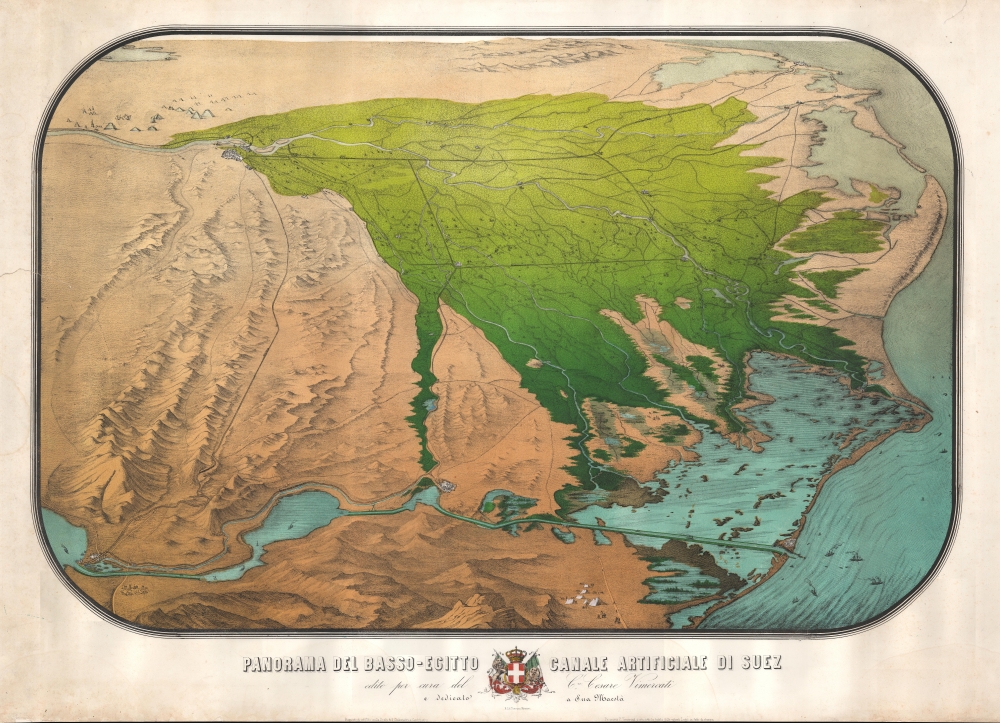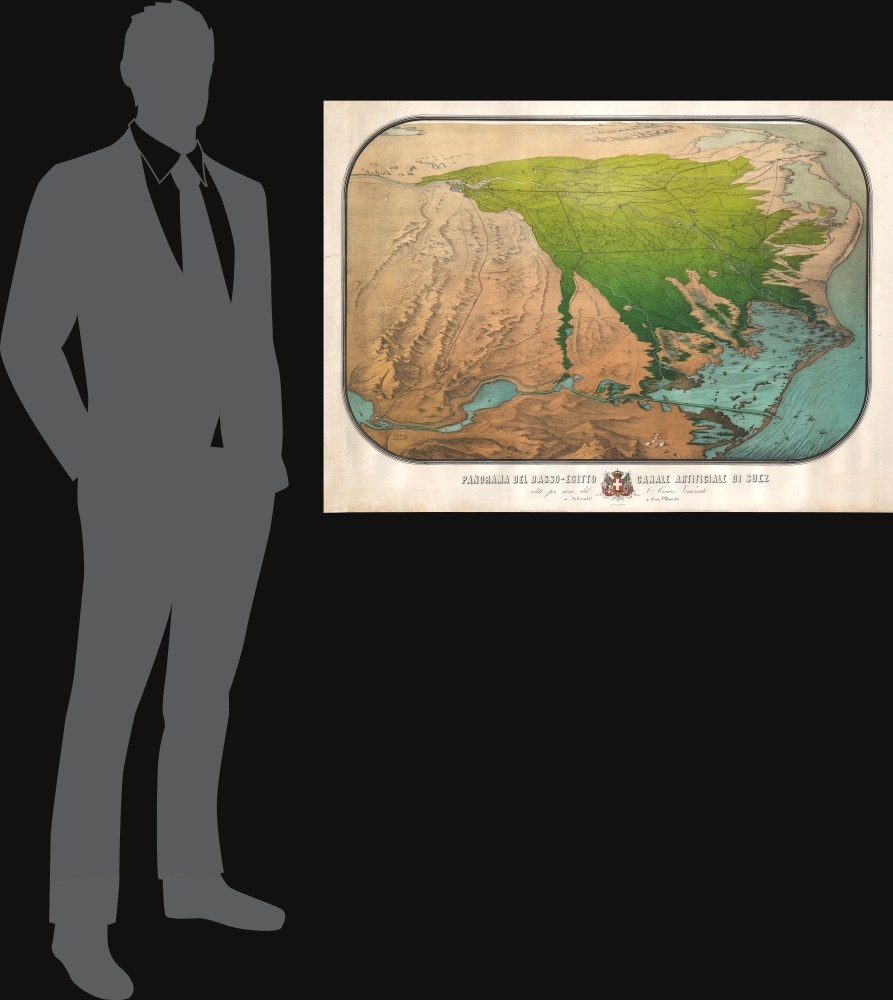1869 Vimercati Bird's-Eye View of the Suez Canal
SuezCanal-vimercati-1869
Title
1869 (undated) 27.75 x 38.25 in (70.485 x 97.155 cm) 1 : 260000
Description
A Closer Look
The view is oriented to the west, with the Suez Canal in the foreground, the fertile Nile Delta taking mid-ground, and Alexandria and the Libyan Desert in the background. It illustrates cities, terrain, and connecting railroads between major hubs: Alexandria, Cairo, Port Said, and delta hubs. The view is dedicated to Vittorio Emanuele II, King of Italy.The Suez Canal and the Italian Economy
The maker, Vimercati was a major support of the canal, believing it would revitalize the Italian economy. In 1864, he wrote, Il canale dell'istmo di Suez sua influenza di pace per l'Europa e di rigenerazione per l'Italia. Italy, at the time reeling from years of unification wars, as well as the instability inherit in organizing multiple independence states into a centralized administration. Vimercati saw in the canal a return to Italian maritime glory, lost when the Portuguese opened the sea route to India around Africa in 1497. Upon the completion of the Suez Canal, Italian ports such as Genoa, Livorno, and Venice-Mestre became the most geographically convenient gateways from Central Europe to Asia, leading to a period of prosperity unequalled in modern times. The Italian economy grew consistently from 1861 until the outbreak of World War I (1914 - 1918), much as Vimercati predicted.Suez Canal
The Suez Canal was construed by the Suez Canal Company between 1859 and 1869, officially opening to maritime traffic on November 17th, 1869. The canals cuts through the western Sinai Peninsula between the Mediterranean at Port Said and the Red Sea, at Suez - eliminating the need for cargo ships to navigate around Africa to reach Asia. The Canal thus allowed for significantly faster communication between European ports and the lucrative markets of Asia - a monumentally significant moment in global trade, but particularly important to Mediterranean countries whose markets it expanded exponentially.Work began on April 25, 1859, shortly after the developer Ferdinand de Lesseps obtained a concession from Sa'id Pasha, the Khedive of Egypt and Sudan. He created an international commission consisting of 13 experts from 7 countries to construct the canal. Much of the construction force was conscripted labor under the corvée system, which was common in Egypt until 1882, when it was outlawed. The British initially opposed the canal, out of fear it would disrupt English dominance of maritime trade, but in 1875 when Said Pasha's successor, Isma'il Pasha, ran up excessive debt, the British government acquired 44% of canal. In 1888, it was declared a neutral zone under British protection. Today the canal is under Egyptian control.
Chromolithography
Chromolithography, sometimes called oleography, is a color lithographic technique developed in the mid-19th century. The process involved using multiple lithographic stones, one for each color, to yield a rich composite effect. Oftentimes, the process would start with a black basecoat upon which subsequent colors were layered. Some chromolithographs used 30 or more separate lithographic stones to achieve the desired product. Chromolithograph color could also be effectively blended for even more dramatic results. The process became extremely popular in the late 19th and early 20th centuries, when it emerged as the dominate method of color printing. The vivid color chromolithography produced made it exceptionally effective for advertising and propaganda imagery.Publication History and Census
This view was lithographed in Florence by Litografia Toscana on behalf of Cesare Vimercati. There are two known states, the present example, dedicated to Vittorio Emanuele II, King of Italy. A second state, without the dedication is also known. We note no other holdings of the present state, but the undedicated map his held at the David Rumsey Collection and at the Library of Congress.CartographerS
Cesare Vimercati (fl. c. 1840 - 1870) was an Italian author, journalist, historian, and publisher active in the mid to late 19th century. He was the son of the Milanese mandolin virtuoso Pietro Vimercati (Milan; 1779 - 1850), himself the son of famous instrument maker Gaspare Vimercati.. During the Oriental Crises of 1840 he was an embedded journalist in Ottoman Syria, sailing there with the Austrian Frigate La Guerriera. More by this mapmaker...
Litografia Toscana (fl. c. 1850 - 1910) was an Italian lithographic firm active in Florence during the mid to late 19th century. Learn More...




